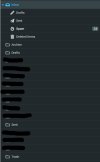Hello Kaspar,
first of all, thank you for the information.
No, I have not installed or activated Plesk Premium Mail. Nevertheless, this file accessed the folder structure and changed the layout. I only tried it out in the past. The extension is deactivated. Especially with such a poor rating.
Initially, the mailboxes were: Sent, Drafts, Deleted, and Spam as subfolders. (After the first Dovecot update) Then I adjusted all the folders and restored the “normal” state.
Yesterday, I performed the next update via Plesk, and afterwards the spam folder was once again a subfolder of the inbox. I then tried to delete this folder, but it was automatically recreated, even though I had already customized the configuration in Roundcube and Dovecot.
After searching for the file that recreated this folder, I came across 93-kolab.conf and adjusted the folder again.
After that, the spam filter no longer worked. And then I came across the file: 93-kolab-antispam.conf. This file was missing the entries for the extensions that ensure that spam is moved to the spam folder. I also created a Python file that correctly describes a TXT file with logs so that the spam folder can learn correctly again.
This action simply went too far for me. Something like this should not be allowed to happen. That's why I will outsource the mail server in the long term or deactivate it in Plesk. The trust of my customers and myself is gone.
I have two more questions: Why does Dovecot.org create instructions for a backward installation when something new has been released? The second question is: Why doesn't Plesk intervene in the “new setting” and reject this change? It feels like taking my car to the garage for inspection and suddenly finding different seats installed when I pick it up.

